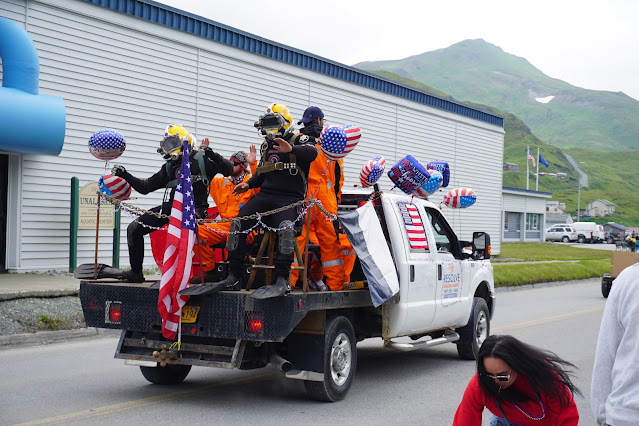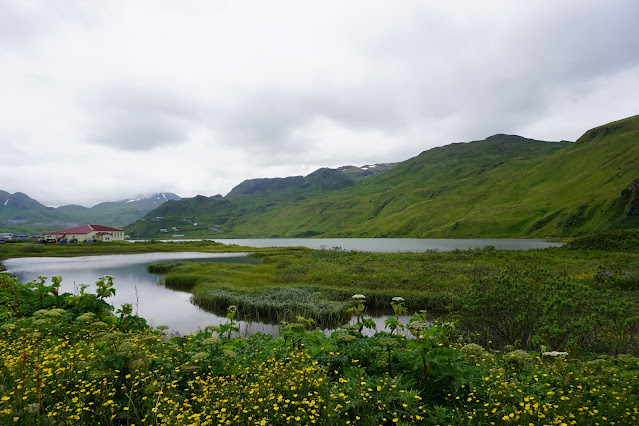Irene Returns Home via the “Birthplace of the Winds”
 |
| June 1, 2021 - July 29, 2021 |
 |
| Gale NW Pacific Ocean |
As expected, our passage from the Japanese island of Hokkaido to the American island of Attu in the Aleutian Island chain of Alaska was blessed by plenty of wind, rain, and fog. Seki-san, our advisor and host in Kushiro, Japan, nodded approvingly as we declared our intention to depart in the morning. “Perfect weather!” he declared. He had brought big bags of onions and asparagus as a parting gift to us. Our timing was dictated by the arrival of a low pressure system delivering rain but also plenty of wind to the region. “Don’t go too close to Russia!” he warned. The great circle route we intended to follow did take us close to the Kuril Islands, where his family had lived until they were expelled in 1945 when those islands were changed from Japanese to Russian ownership.
We appreciated Seki-san’s sailorly wisdom. In the past, in other parts of the world, well intentioned people have given us poor advice suggesting that we depart port in a calm in fear of stormy weather. But the truth is, at these latitudes low pressure systems sweep by regularly, bringing wind alternating with calms, and wind certainly beats calm if one wishes to have a good passage.
Great bullets of wind swept the Kushiro harbor as we motored out, and Seki-san stood on the quay and waved until we could no longer see him. We set mizzen and jib, and never needed the mainsail on the passage to the Aleutians.
 | |
| Sea Mood N. Pacific Ocean |
The passage was a chilly one for us. Irene has three sources of cabin heat; a Danish made Refleks oil drip heater, a Russian made diesel hot water boiler, and a Dutch kerosene hanging lamp. Unfortunately, sometime during our time in the tropics when it had been stowed in a locker, our lamp had corroded into a useless lump. Only the hanging lamp is suitable for gale conditions at sea, the other two are not able to keep running in big wind and seas. We resorted to baked potatoes and hot water bottles to cope with the damp and cold while underway.
Mindful of Seki-san’s advice, we did not stray too close to the Kuril Islands. Even so, we were politely interrogated over the VHF radio as we passed Russian fishing vessels, who relayed questions from officials on shore. We settled into our watch routine and soon enough we were approaching Attu, very carefully, in dense fog. Our route took us past unseen dangers – we could hear the surf but couldn’t see a thing – until our final turn into the wind to furl the mizzen. Then, wonderfully, the fog became thin and wispy. We entered a pretty little cove and dropped the hook after a ten day passage.
 |
| Irene at Navy Cove, Attu |
 |
| Irene off Quonset Hut, Attu |
Eager to explore the very westernmost territory of the USA, we launched the dinghy and rowed ashore.
 |
| Navy Cove, Attu AK |
 |
| Attu Shore Boat |
Attu was the site of fierce fighting during WWII. American and Canadian forces suffered many casualties as the Japanese defenders fought almost to the death, only 28 surviving of thousands. The US maintained military presence on the island in the years after the war. There is a large runway, still maintained as an emergency field, and a Coast Guard Loran station (boarded up) as well as many derelict Quonset huts, piers, and other relics. No one lives on the island, although there are security cameras on some of the buildings. We guess the cameras are monitored on nearby Shemya island, which is a current military installation and strictly off limits.
 |
| Attu Motor Windings on the Beach |
 |
| Attu Barracks |
 |
| Attu Quonset |
 |
| Attu Memorial |
The only sounds we heard were surf, blowing wind and honking geese. As we walked and explored and enjoyed the natural beauty and interesting artifacts, we couldn’t help but think of the people who had once lived on this island – native Aleut people, Japanese military, and American military – now all gone. The sense of isolation was quite a change from our recent cruising in heavily populated Japan.
 |
| Attu Marsh Pond |
 |
| Beach Road, Pyramid Cove, Attu AK |
 |
| Exploring Attu |
 |
| Interesting Debris, Attu |
Back aboard Irene we dried damp bedding and cushions, attended to the usual small repairs, cooked and ate in blissful warmth and comfort.
 |
| Epoxy Deck Repair, Attu |
 |
| Alaska Boots Back in AK |
 |
| Captured in Attu |
A couple of days later the weather forecast predicted wind, so we took one last trip ashore before moving on. This island is known to be a birder’s paradise. Spotting is easy since there are no trees, and birds from North America and Europe mingle here.
 | |||
| Attu Finch | |
 |
| Attu Caution |
 |
| Attu Loons |
 |
| Attu Goslings |
Wind arrived and so we headed on. Our next destination was the island of Kiska, the site of another major Japanese base during the war. We made good time and arrived after a single overnight. After anchoring, we rowed ashore, pulling the dinghy up on a beautiful black sand beach.
 |
| Kiska Beach |
The US bombed the heck out of Kiska in 1943 in preparation of an Allied landing to retake the island from the Japanese. Seven million pounds of explosives were dropped, and the landscape shows the scars to this day.
 |
| Irene off Kiska - Eroded landscape of bomb craters |
When the first Allied troops came ashore after the bombardments, they were greeted only by a half a dozen dogs. The entire Japanese garrison had departed weeks before, undetected in the fog that regularly blankets these islands. Unfortunately, the Allied commanders couldn’t believe the fact the Japanese were gone, and over the few next days as American and Canadian forces blundered about in the fog the Allies suffered 200 casualties to friendly fire, inadequate clothing and other mishaps.
 |
| Kiska WWII Relics |
It was interesting to poke around the military hardware lying about, seeing Japanese characters on one item and American marks on another, all jumbled together.
 |
| Kiska - Peter checks out an aircraft engine |
 |
| Kiska Pier |
 |
| Kiska Ship Wreck - Japanese cargo ship |
Our next hops took us to Kanaga, where we anchored in front of a long abandoned fox farm, then to Adak to top off our fuel.
 |
| Fox Farm Relics, Kanaga |
 |
| Fox Farm Bunkhouse, Kanaga |
 |
| Heerrre's Peetey! |
 |
| Adak Fuel |
The Adak fuel attendant, a friendly young Aleut man, told us that his grandmother had lived on Attu and had been forced to evacuate in 1942. With full fuel tanks, on we sailed to Igitkitin, and next to Atka. We grew to love the windswept beauty of the Aleutian Islands.
 |
| Aleutian Beauty |
 |
| Whales! |
Irene continued on to Unalaska and the port of Dutch Harbor. Here we crossed our outbound track (of 2017) just one day short of four years later, completing our second circumnavigation. It was fun to be in familiar territory again. We had a beer at the Norwegian Rat Saloon to celebrate.
And finally here, at the Unalaska native clinic, we were able to receive COVID vaccines. Thankful for the opportunity, we resolved to stay put long enough get our second doses.
 |
| Serene Unalaska |
 |
| Dead Tree Park, Unalaska |
 |
| Unalaska Rain |
 |
| International Visitor Dock |
 |
| Unalaska Ground Squirrels |
 |
| Unalaska July 4th Independence Day Parade |
 |
| July 4th, Unalaska Style |
 |
| Unalaska Lake |
 |
| Unalaska Fox |
 |
| Resident Otter |
 |
| Subsistence Fishing |
 |
| Russian Orthodox Church, Unalaska |
After our second inoculation, we were free to head on to Puget Sound and our home port of Ballard. We planned to sail directly, across the Gulf of Alaska, because Canada remained closed due to COVID. Our repair (heater exhaust hose & front crank shaft seal) and replacement (new kerosene lamp) items arrived and been installed and we looked forward to a warm passage.
 |
| Heater Exhaust Inspection |
 |
| Lamp for Heat - Our new kerosene lamp proved to be even warmer than it's predecessor. |
 | |
| Akutan to Port |
We left in a good wind (Seki-san would approve) and only needed to set jib, staysail, and mizzen to maintain our passage speed. The main remained furled most of our ten day passage to Neah Bay. Just before we came in sight of land, the sacrificial tube on our Monitor wind vane failed. We have carried a spare tube for two entire circumnavigations without ever needing it. And amazingly, now that we needed it, we were actually able to find it - deep in a locker though it was! The repair was easy, and with perfectly lucky timing we dropped anchor in Neah Bay just minutes after sunset.
 |
| Failed Wind Vane Tube |
 |
| Juan de Fuca |
Over anchor-drams, Ginger and I reflected on our recent years of sailing. The pandemic had changed the sailing world dramatically, as so many countries had denied us entry. It was disappointing to sail past places we had long wanted to explore. But on the other hand, we successfully navigated during a difficult time and brought boat and crew home safely. Not all cruisers were so lucky. Some yachts that were left at anchor as their owners departed to fly home have already been damaged or lost as they blew ashore. Others were left at marinas and are costing hard earned money for moorage as they deteriorate, and their owners are not yet able to even visit with borders remaining closed now over a year and a half since they left.
Because of long hours at sea and in quarantine, our choice to sail directly home gave us time to gain a deeper understanding of ourselves and our boat, sea and sky, and our fellow creatures – sea birds, fish, marine mammals. And people! Our interactions exposed us to good and bad – many people with wonderful kindness and compassion helping us, fearful people shunning us, opportunistic people sensing our vulnerability to plunder, and opaque officialdom issuing quirky and incomprehensible orders.
Looking forward we plan to recuperate and repair, as boat and crew are worn and weary. And we’ll sail only locally for a while – as Ginger says, “NO. MORE. BORDERS!”
 |
| Approaching Adak |



Comments
Post a Comment